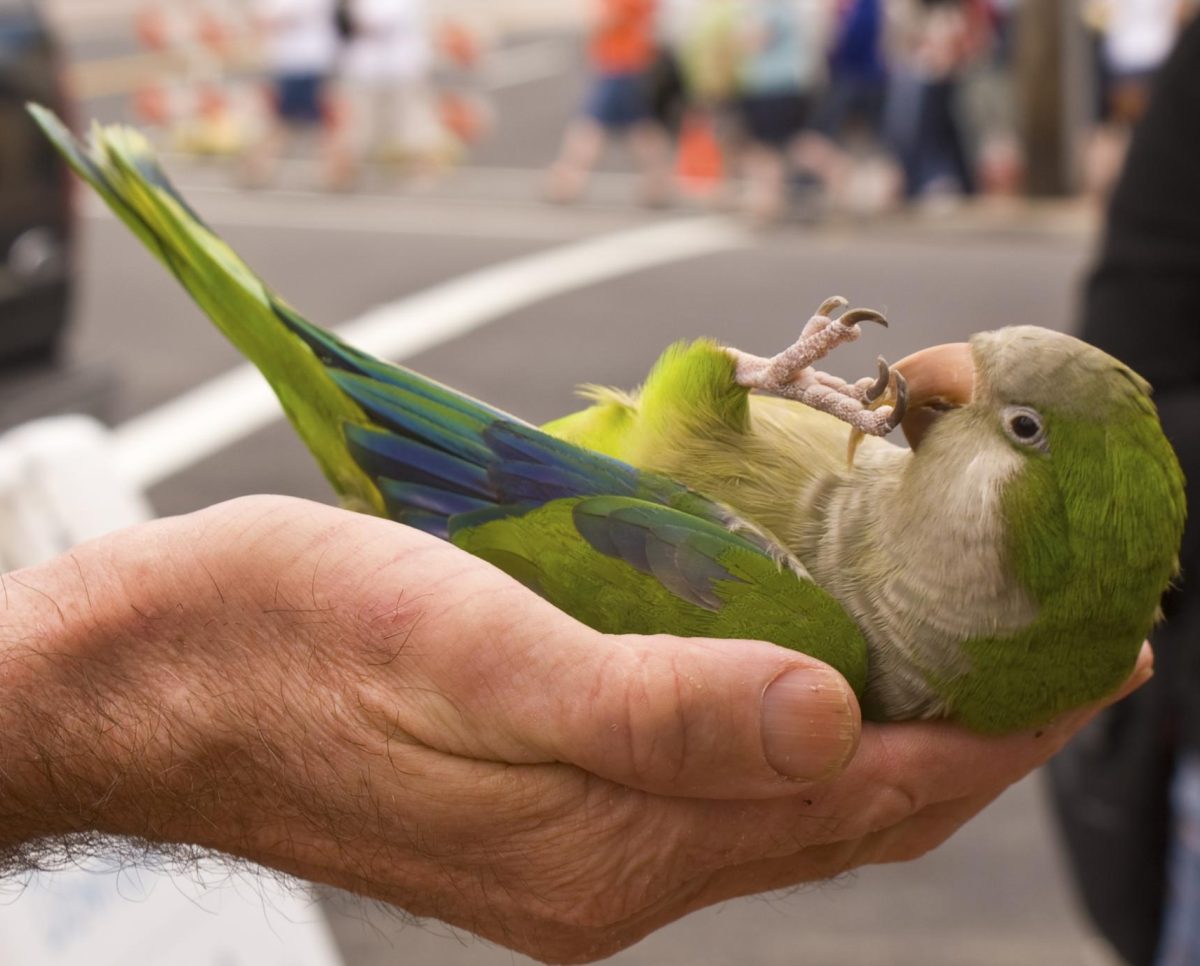Within Austin lies (or flies) a large population of monk parakeets. Many Austinites are aware of them and value these little, green parrots for their exciting behavior and colorful appearance. Their natural range is in southern South America, so why are they here? Well, a small number of them were released in the ’80s near Zilker Park and since then have boomed in population spreading to many different corners of the city. They are also known to be in Houston, San Antonio and many other states in the United States. While they have a pretty basic origin story, these little parrots could be useful to the United States and fill an extinct role that hasn’t been filled in 104 years within the Midwest, Northeast and Southern states.
Because monk parakeets are an invasive species, it is imperative that we determine if they are a threat to our ecosystems and major way of life. Gathering information from European countries, we know monk parakeets can be pests for agriculture. We also know from experience and reports in neighboring cities that their nests are hazards to electrical structures. Like little apartments, monk parakeets make 400-pound stick nests housing multiple birds and eggs at the same time. This is something completely unique to monk parakeets, but as cool as it is, their nests can create problems. Interfering with electricity passing through power lines can cause power outages and even fires, although this is rare and it seems to be unrecognized within Austin or just so infrequent it is not worth a discussion. This, along with being an agricultural pest, are the two main problems that have been seen within this species, besides those two I have not seen anything else negative associated with monk parakeets.
With our understanding of the KNOWN negatives, we can safely say that they do not bring any dangers to our native wildlife and way of life, so what about the positive influences this species would provide? The role of parrots is to spread forests and while many species do this, parrots are on another level. With super strong beaks they can crack many different types of seeds to eat. Already, monks have been seen eating native tree seeds. Timothy Keitt, a UT ornithology professor, has observed them eating the important and native mesquite tree seed pods. This small observation is important as it means that monk parakeets can be a reliable seed distributor and that they can survive off of native plants, along with that they also are observed foraging off the ground further expanding the fact of their great adaptability. Monk parakeets are also omnivores, so while plants are the main dish, insects and meat are not out of the question.
Their aforementioned giant nests are an example of ecosystem engineering. An ecosystem engineer is a species that can modify habitats and this can be done in different ways, but monks fall into the allogeneic engineering category. Allogeneic engineers modify their ecosystem physically like beaver dams, or some caterpillars making leaf shelters. All of these structures can help native life, and the monks specifically help make homes like the mentioned caterpillar. We have observed many different animals taking residence within monk nests but primarily birds. And a great diversity of birds there are, even including birds of prey. Mammals, reptiles and invertebrates can also be found in their nests, but they probably would not cooperate as well if at all with monks. Following that, in a study of monk nests, 31 cases of monks and other bird species have helped each other in defending the nest. Now this won’t always work out and a monk nest may never hold another species but an abandoned nest can be taken from there. Either way, it positively affects the ecosystem and can boost native populations. The negative is that invasives can also take residence, so the location where monks would be introduced needs to be an invasive free or low populated area.
With the positives and negatives of the species, I want to clarify the headline of this column. Proxy is a commonly used term when a species has gone extinct and a closely related or species with a similar ecological role is introduced into an area to keep the ecosystem from dying, becoming unbalanced, or just generally helping the ecosystem out. An example is the bolson tortoise, in the fossil record we know that these tortoises used to be in large numbers around the United States in the Pleistocene era and continued in the Holocene but decreased substantially later on. These tortoises help support grassland and shrub-land simply by their way of life which in turn creates soil humidity needed for said biomes. This method of rewilding can be an extremely positive way to bring back the health of ecosystems, but the whole idea is quite sad. We are at a point on Earth when we have to resort to using the extinct to save our living species including ourselves, but by using some extant life we can make up our mistakes. This is the reason I propose the monk parakeet. But what species does it proxy for?
Conuropsis carolinensis, also known as the Carolina parakeet, was the only widespread North American parrot species we know of since the Miocene, that species is known as Conuropsis fratercula. Yes, other parrot species have lived in the United States like the thick-billed parrot that used to roam west Texas, Arizona, New Mexico and Utah. Or the green parakeet being in the tip of Texas and possibly having a much further extension in the past, but none as widespread as the Carolina parakeet. The Carolina parakeet was a small and brightly colored parrot being green with a yellow to orange head and filled the role of a tree seed disperser. Its extinction in 1918 was traced to mass hunting and the major deforestation in the 18th and 19th centuries.
While many other things have led to the decrease of forests in the United States, I can say for certain that the extinction of the Carolina parakeet is one of them, and for all we know it could have had another eco-role besides seed dispersal as before its extinction we didn’t even have that much info on it to begin with. While de-extinction isn’t impossible, it is hard. This is where the monk parakeet comes in. The monk parakeet’s role and behavior are so similar to the Carolina parakeet making it the best candidate for a proxy, and as stated previously the large nests they make can be a completely new plus to introducing them into our ecosystem, not just a seed disperser but also making homes for others. If this idea were to be taken into full effect, the best start would be to find an adequate area, I think somewhere in the middle of Arkansas could work. Then chipping the monk parakeets so that if anything backfires we know immediately where they are for recapture or termination and full monitoring of the individuals to see how they interact with the ecosystem. If everything works out the final step is taken: Introduction of monk parakeets in the Midwest, Northeast and Southern states, 30 in total.
We have the ability to rejuvenate our dying planet, but this can only be accomplished if the human race can cooperate. Too many species have been lost in our wake, and each loss has tipped us further into our own extinction.









Trish • Aug 12, 2024 at 6:44 pm
Thanks for a wonderfully thoughtful and informative article. I have seen a couple of monk parakeets around and at first I thought someone’s pet parakeet escaped, then I wondered how they got here. Very hopeful news that they may act as a proxy for the Carolina parakeet. I hope they will introduce and monitor them in Arkansas as you suggest
Anna • Jun 18, 2024 at 4:05 pm
An incredible read and great piece!
Karen • Apr 25, 2024 at 6:27 pm
I learned a lot from this article about the monk parakeets that I’ve seen around Austin. This is a hopeful and informative piece!
kiarapadilla • Oct 27, 2023 at 2:03 pm
its a really good and interesting picture
Reiya • Oct 27, 2023 at 1:58 pm
I had no idea monk parakeets were released here! that “Within Austin lies (or flies)” made me giggle, that was smart